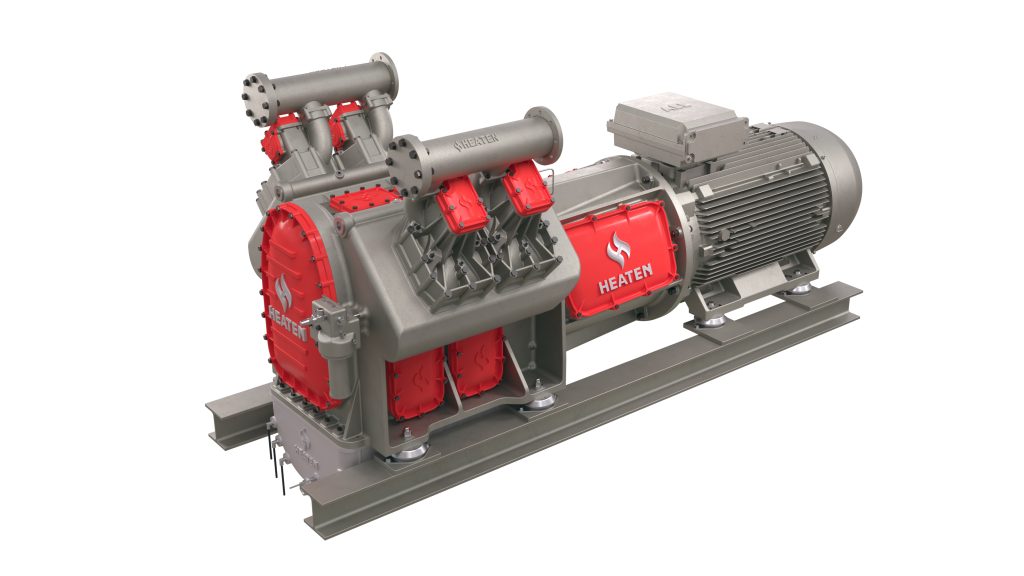How does it work?
Industrial heat pumps actively recover waste heat. The system is rather simple: heat pumps increase the temperature of waste heat streams to a higher temperature, making those streams usable again. A heat pump supplies heating and cooling at the same time.
The heat pump operates on the basis of a working fluid (refrigerant) which changes state (liquid/gas) in a continuous cycle and absorbs and releases heat (Carnot cycle).
Heat pumps can find application in numerous industrial processes and are particularly efficient when direct heat exchange is not possible, going even beyond a closed circuit and allowing the creation of an integrated system with different processes or users.
The process:
-
Evaporation
In the evaporator, the refrigerant is exposed to the heat source (e.g. industrial waste heat). There, the refrigerant evaporates at low pressure and low temperature.
-
Compression
The compressor increases the pressure of the refrigerant to a higher pressure and temperature level.
-
Condensation
In the condenser, the energy of the working fluid (refrigerant) is transferred to a distribution medium (e.g. water, steam or air) or a heat consumer. The refrigerant is cooled and becomes liquid again.
-
Expansion
In order to close the heat pump loop, the working fluid is fed into an expansion valve. The low pressure low temperature liquid is ready to enter the evaporator again.
Unique for Heaten's piston compressor
-
Flexible
Largest flexibility regarding temperatures and load range. Easy to optimize based on operating temperatures. Different cylinder versions enable adaptations to each application.
-
Working Fluids
Fully free to choose from a range of working fluids. Independent from compressor design (versus e.g. turbo, piston is the only technology that can have a variable compression ratio). Design allows to use different HFO's and HC's with a low Global Warming Potential (GWP).
-
Efficiency
Efficiency curve is almost “flat” over 20 – 100% load range. Technology platform is already designed and tested for 215°C. Piston machines typically have mechanical efficiencies higher than 90%.
-
Durability
Heavy-Duty building on technology which is used to much higher temperatures. Heavy duty design to deliver 80,000 hours runtime between major overhauls. Heaten IP key to durability of high viscosity oil through separation of refrigerant and lubricants.
-
Serviceability
A piston compressor is a globally known technology. Access to qualified service and maintenance personnel in ubiquitous.
-
Scalability
Heaten's compressor uses similar components compared to a Heavy-Duty combustion engine. This guarantees fast production scalability at low costs.
Heaten today
With 13 years of R&D, design and engineering experience, Heaten has 3 years head start on the competition
June 2023
Demonstrated operation of first HBL4.
May 2023
Testbed facilities are ready in Remscheid, Germany.
June 2022
Detailed design freeze and production of pilot units starts.
January 2022
Heaten signs production agreement with AVL-Schrick.
2020-2021
Development of a large scale VHTP technology platform HeatBooster. The multi-cylinder platform allows up to 8 MWth per HeatBooster and more than 50 MWth per system.
2016-2017
Development of the HBS4, a commercial VHTHP with up to 200 kWth of output heat supply.
2015-2017
Development of pilot for Industrial Very-High-Temperature Heat Pumps (VHTHP), the “HeatBooster”, based on existing technology platform for ORC.
2015-2017
5th generation valve systems and large piston machine design based on established technology platform.
2014-2016
4th generation ORCs (10 kWel and 40 kWel systems) based on the required improvements to the demonstrator base design and provide commercially available systems.
2013-2014
3rd gen. Development of “commercial”-grade ORC demonstrators (10 kWel, index ‘el’ electric output) to mimic realistic customer requirements, and to execute extensive performance and durability testing.
2012-2013
2nd gen. ORC. Moving to a professional design process by collaboration with AVL/AVL Schrick and continued collaboration with DTU/IPU, which lead to the development, manufacturing and testing of Prototype B.
2011-2012
1st generation ORC.
2010-2011
Assess scientific evidence for developing a small-scale ORC (Organic-Rankine Cycle) for various markets.
Industries & processes
Industry needs Heaten’s technology to efficiently deliver processes heat above 130 °C.
See all industries
Pulp & Paper
- Drying
- Steam supply
Food & Beverages
- Distillation
- Pasteurization
- Sterilization
- Drying
- Spray Drying
- Blanching
- Concentration
- Smoking
- Boiling
- Evaporation
- Scalding
- Tempering

Chemicals
- Distillation
- Compression
- Thermoforming
- Concentration
Automotive
- Resin moulding
- Paint drying
